Located in the midwestern region of the country, Missouri is the 21st largest state. The state’s greatest geographical features are the Ozark Mountains – home to minerals and timber, as well as recreational activities and forested highland locals and tourists can visit and enjoy as they please. Missouri was admitted to the Union in 1821 (on the 10th of August) and is now often called the Show Me State.
Speaking of visitors, the state’s national parks and recreational areas brought almost 17 million tourists back in 2005. According to statistics, Missouri saw about $8 million in revenue that year.
Missouri is home to highly diverse fauna, flora, and endemic species. The state is known for being mostly covered in fresh water from the many lakes and rivers that cross it (the Mississippi River, Missouri River, Table Rock Lake, and Lake of the Ozarks). This includes hundreds of tributaries, smaller lakes, and streams.
In today’s article, you’ll find out more about some native plants of the state. If you plan a visit to Missouri, you should keep an eye out for these!
What Is a Native Plant?
Native plants, also called indigenous, can survive, develop, and adapt to a region’s climate, light, soil, and temperature conditions. This process usually lasts for thousands of years – this being one of the main characteristics that plants must fulfill to be called native.
In short, any plant that grows naturally (without human introduction) and has lived in a region or area for thousands of years can be called native.
10 Native Plants in Missouri
1. Rose Turtlehead

The rose turtlehead can grow up to 2-3 feet tall.
©imageBROKER.com/Shutterstock.com
| Rose Turtlehead | |
|---|---|
| Scientific name | Chelone obliqua |
| Type of plant | Perennial |
| Distribution | Various central and eastern states, including Missouri. |
Also known as the red or pink turtlehead, the rose turtlehead is a plant native to almost 20 states of the U.S. and also native to almost 20 states (in the southeast). It is named after its colors when in bloom – usually a shaded pink, but the plant can also exhibit white or purple colors.
The rose turtlehead is perennial and can grow up to 2-3 feet tall (about 61-91 cm). It also spreads quite a lot, covering surfaces of about 1-2 feet (30-61 cm).
Its main characteristic is the very shape of the flower. As the name suggests, it resembles the head of a turtle.
2. Black-Eyed Susan
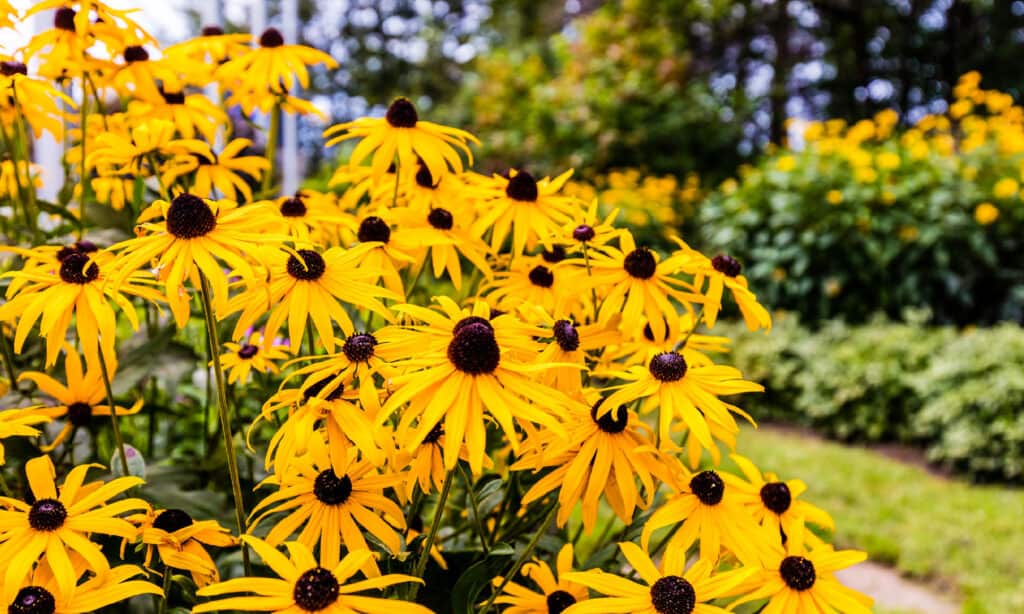
The black-eyed Susan is the state flower of Maryland – it is, however, native to Missouri as well.
©iStock.com/Dopeyden
| Black-Eyed Susan | |
|---|---|
| Scientific name | Rudbeckia hirta |
| Type of plant | Annual (but can be perennial or biennial) |
| Distribution | Eastern and Central North America. |
The black-eyed Susan is the state flower of Maryland – it is, however, native to Missouri as well. There are multiple cultivars of this plant – some variations are spread to the southeastern and south-central United States (var. angustifolia). In contrast, others can be found only in the eastern part of the U.S. (var. hirta).
This usually upright annual plant can grow up to 12-39 inches (30-100 cm) and covers an area of about 12-18 inches (30-45 cm). It is mainly characterized by its wide flowers (which can grow up to 4 inches (10 cm) wide, which feature ray florets surrounding black or brown epicenters.
3. Doll’s-Eyes
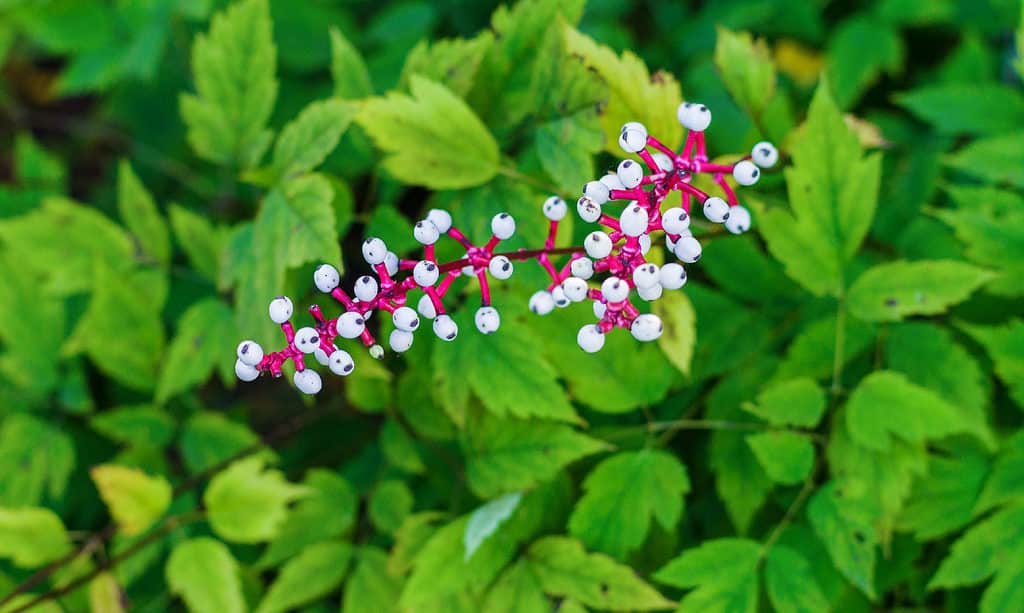
Doll’s eyes can grow up to 18-30 inches tall.
©Alex Polo/Shutterstock.com
| Doll’s-Eyes | |
|---|---|
| Scientific name | Actaea pachypoda |
| Type of plant | Perennial |
| Distribution | North America, Midwestern, and Eastern U.S. |
Also named white baneberry, Actaea pachypoda is native to multiple states in the U.S., including Missouri. You can find it in your travels through eastern Canada and the Eastern or Midwestern U.S. – especially within mixed or hardwood forests.
The plant can grow up to 18-30 inches (46-76 cm) tall. It is a rather peculiar plant – it features fruits (from which its name stems) that are usually not surrounded by leaves. Actaea pachypoda’s fruits are about ½ inches (1 cm) wide. They resemble a doll’s eye – large, round, and with a black dot in the middle.
4. Yellow Giant Hyssop
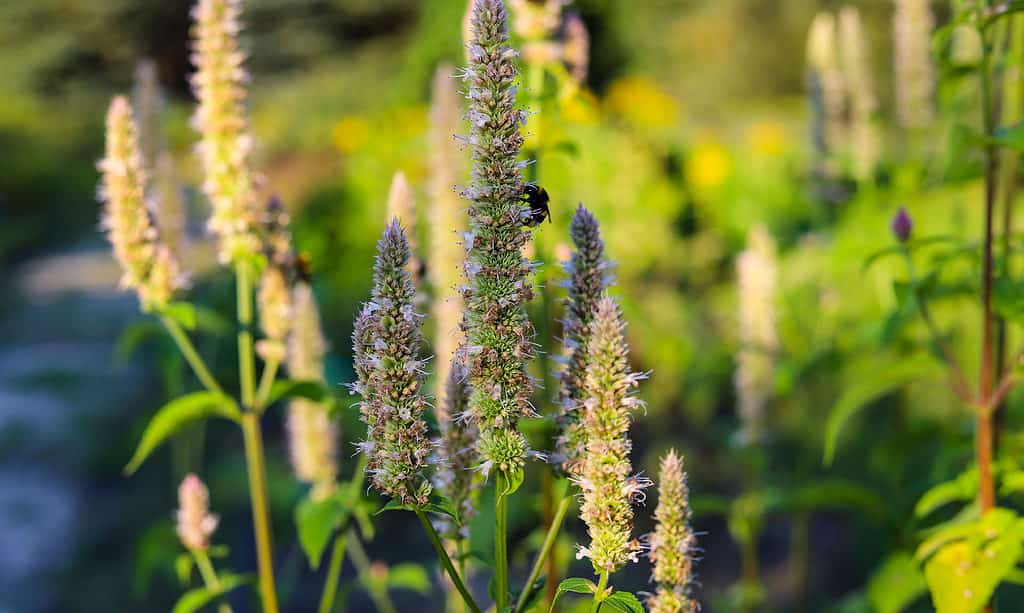
Yellow giant hyssop is commonly found in central and eastern regions of the United States and Canada.
©Kabar/Shutterstock.com
| Yellow Giant Hyssop | |
|---|---|
| Scientific name | Agastache nepetoides |
| Type of plant | Perennial |
| Distribution | Central and Eastern United States, Canada |
Member of the mint family, the yellow giant hyssop is commonly found in central and eastern regions of the United States and Canada. It is regarded as a secure plant in terms of its conservation status.
Agastache nepetoides can reach impressive heights – up to 4-7 feet (1.2-2.1 m) tall. The plant has a single, straight stem and only a few branches. The stem is characterized as winged and hairless.
You can see yellow giant hyssops if you visit lowland thickets, woods, meadows, or upland deciduous forests.
5. Cardinal Flower
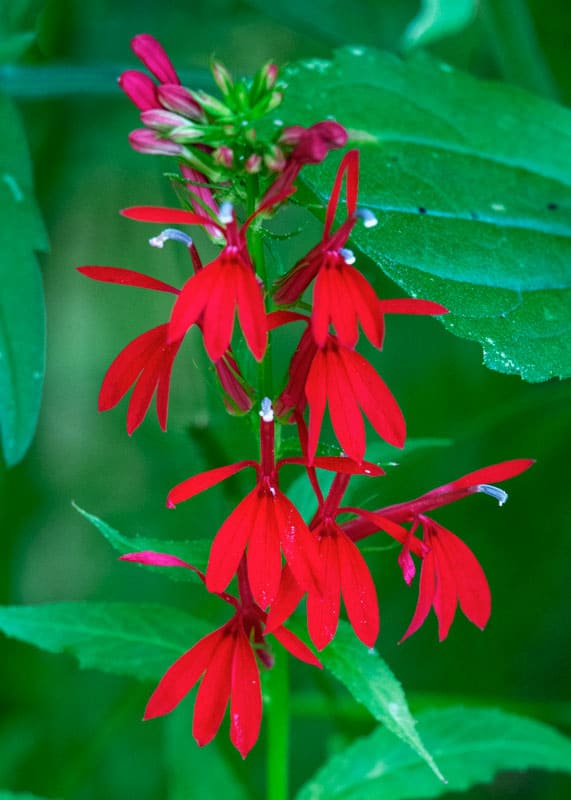
The cardinal flower features leaves about 8 inches long and 2 inches broad.
©iStock.com/Jen Tepp
| Cardinal Flower | |
|---|---|
| Scientific name | Lobelia cardinalis |
| Type of plant | Perennial |
| Distribution | Southeastern Canada, Eastern and Southwestern U.S., Central America, Mexico, and Northern Colombia. |
Lobelia cardinalis can be found throughout the Americas, native to many states and countries (including Missouri). It is part of the Lobelia genus and is not an endangered plant (Least Concern).
The cardinal flower can grow up to 4 feet (1.2 m) tall and features leaves of about 8 inches (20 cm) long and 2 inches (5 cm) broad. As expected, it can be easily distinguished by its vibrant deep red flowers. They present five lobes and spread about 1.5 inches (4 cm) across. The plant prefers swamps, streambanks, and generally wet places.
6. White Beardtongue
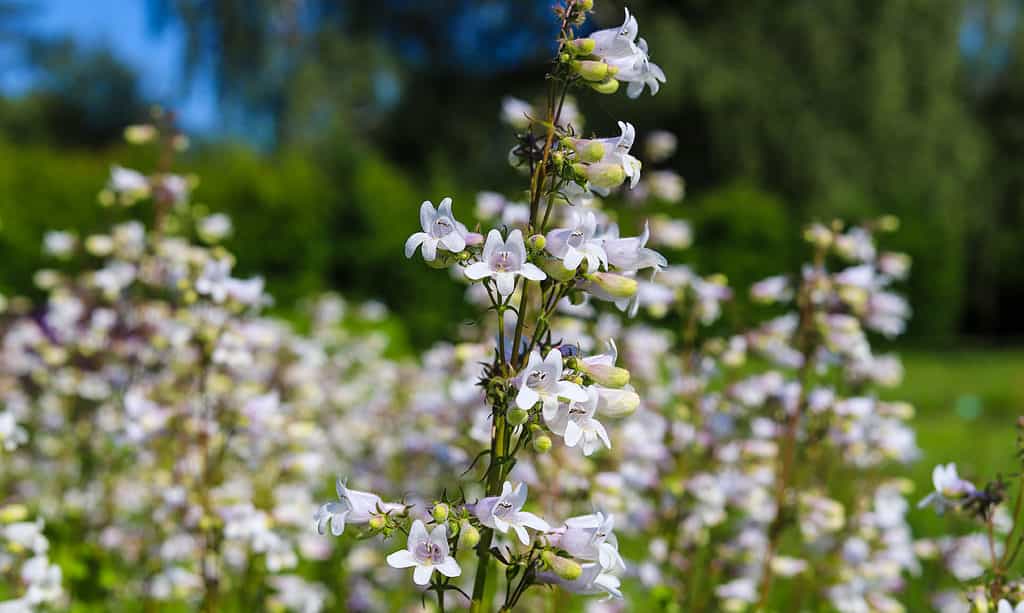
The white beardtongue is also called foxglove beard-tongue and talus slope penstemon.
©Kabar/Shutterstock.com
| White Beardtongue | |
|---|---|
| Scientific name | Penstemon digitalis |
| Type of plant | Herbaceous |
| Distribution | Eastern Canada, Eastern and Southeastern United States |
The white beardtongue is also called foxglove beard-tongue and talus slope penstemon. The plant is the most widespread Penstemon species east of the Mississippi. It can be found in the eastern and southeastern parts of the United States and in eastern Canada.
Penstemon digitalis features slender stems that bear white flowers. The latter grows on flowering panicles that cover almost a third of the plant’s total height. Your chances of seeing this plant increase if you venture through meadows, fields, open woods, prairies, and even railroad tracks. Just make sure to keep an eye out for sandy and moist soils!
7. Shining Blue Star
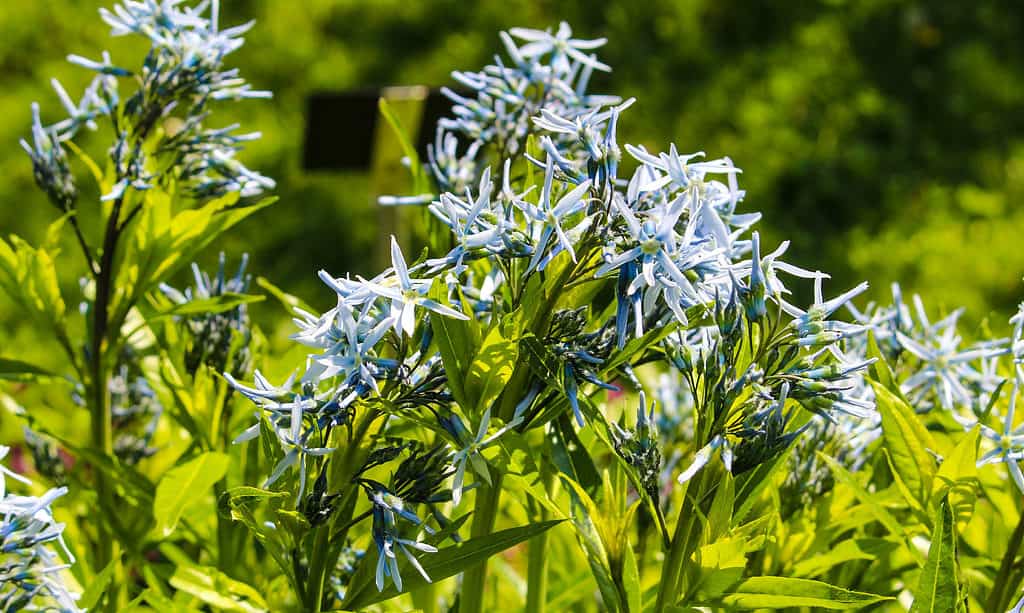
The shining blue star is common to the Mississippi Valley.
©RukiMedia/Shutterstock.com
| Shining Blue Star | |
|---|---|
| Scientific name | Amsonia illustris |
| Type of plant | Perennial |
| Distribution | U.S., Western North America |
Amsonia illustris is often called the Ozark bluestar, as it is commonly found throughout the Ozark Mountains (as we mentioned, this formation is characteristic of Missouri). The plant can also be found in marshes, savannas, pastures, prairies, and even plains.
The shining blue star is common to the Mississippi Valley. It is a part of the Amsonia genus, which consists of about 18 species – each native to multiple states within the U.S. It features long, broad leaves and small, faded purple flowers – each flower has about five elongated petals that circle a pale yellow center.
8. False Rue-Anemone
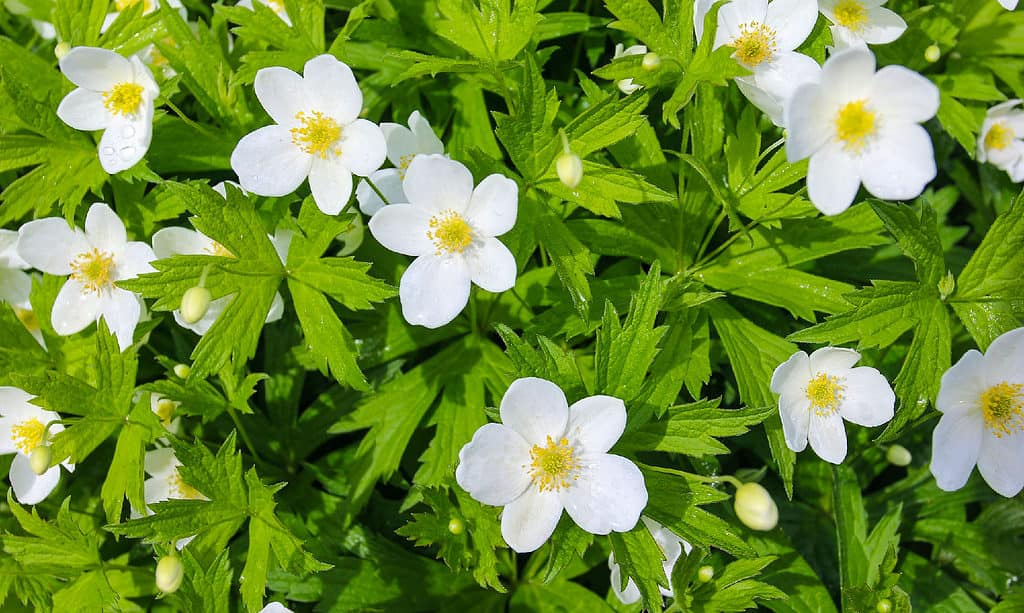
The false rue-anemone is a deciduous woodland plant found in the eastern regions of the U.S. and in the extreme southern part of Ontario.
©iStock.com/walencienne
| False Rue-Anemone | |
|---|---|
| Scientific name | Enemion biternatum |
| Type of plant | Spring ephemeral |
| Distribution | Eastern United States, southern Ontario |
The false rue-anemone is a deciduous woodland plant found in the eastern regions of the U.S. and in the extreme southern part of Ontario. It flowers in the spring and produces evergreen basal leaves in the fall.
As its name implies, the false rue-anemone is often mistaken for the rue-anemone, scientifically called Thalictrum thalictroides. The latter, however, is more likely found in moist bottomlands than deciduous forests.
Striking white flowers characterize it – each specimen can have from two to four flowers per raceme. You might be attracted by its pure white petals, which is a completely normal phenomenon – be aware that they’re not petals but sepals (which have a protective role for the actual flower in bud).
9. Blue Vervain
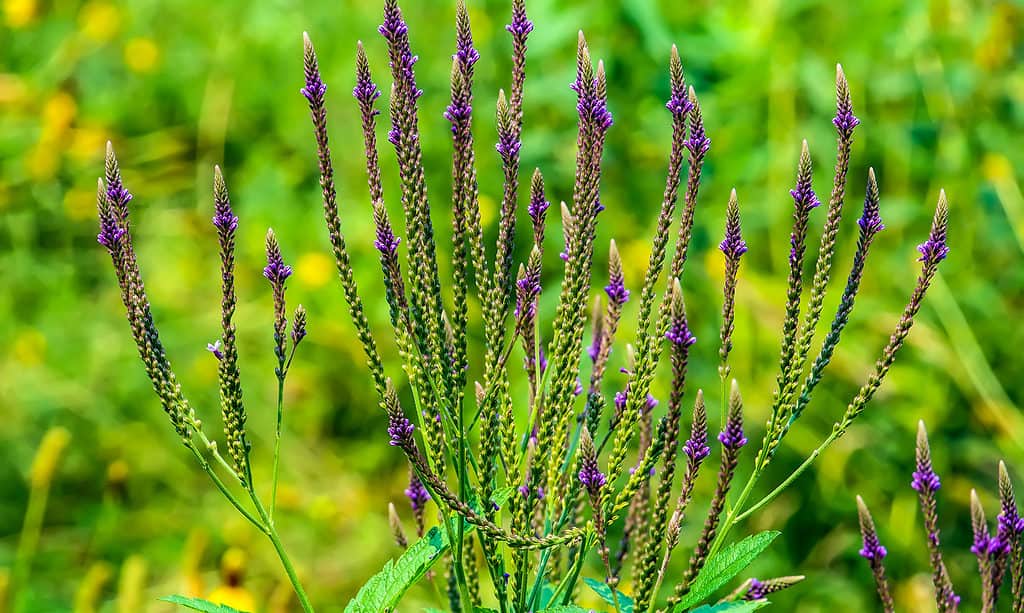
Blue vervain usually features a stiff, hairy, straight stem.
©iStock.com/williamhc
| Blue Vervain | |
|---|---|
| Scientific name | Verbena hastata |
| Type of plant | Perennial |
| Distribution | Continental United States, southern Canada |
Also known as simpler’s joy, swamp verbena, or American vervain, Verbena hastata can be found throughout the U.S. Still, it is most common north of the Missouri River. It is a secure plant and not facing any risks currently.
Blue vervain usually grows up to 5 feet (1.5 m) tall and features a stiff, hairy, straight stem. Regarding flowers, Verbena hastata produces inflorescences of flowering spikes (scientifically called panicles). This group can be about 1 foot (30 cm) long and grows at the end of the plant’s upper stems.
Blue vervain blooms with deep purple or violet flowers – they can also be white, but this rarely happens.
10. Ozark Witchhazel
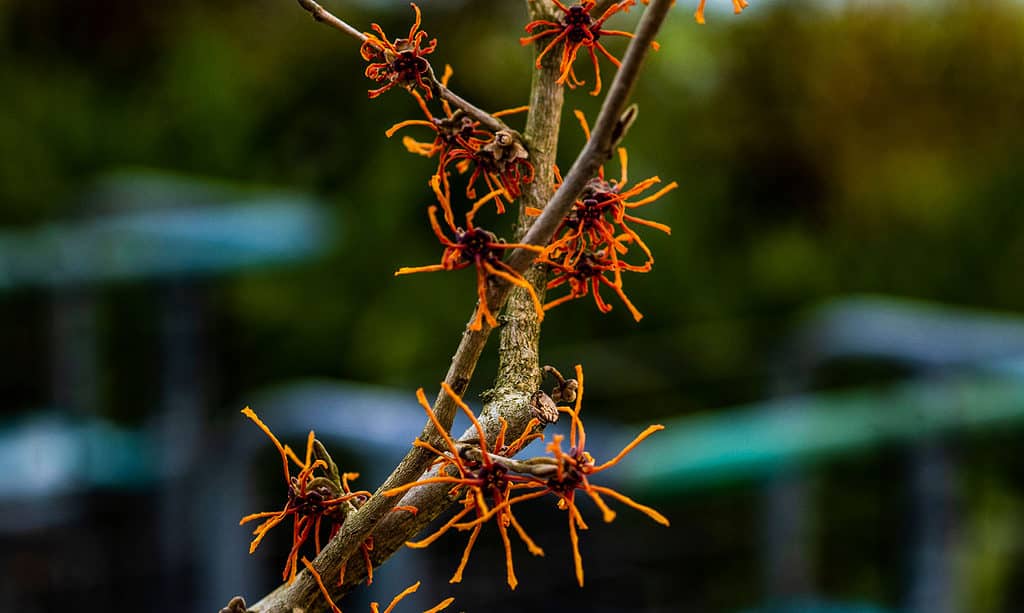
The Ozark witchhazel is a large deciduous shrub found mainly in the Ozark Plateau.
©Dgu/Shutterstock.com
| Ozark Witchhazel | |
|---|---|
| Scientific name | Hamamelis vernalis |
| Type of plant | Deciduous |
| Distribution | Ozark Plateau (Oklahoma, Arkansas, Missouri) |
Part of the Hamamelis genus, the Ozark witchhazel is a large deciduous shrub found mainly in the Ozark Plateau and growing up to about 13 feet (4 m) tall. It has a peculiar aspect, especially when it blooms, exhibiting bright red flowers equipped with ribbon-shaped petals as short as 0.28-0.39 inches (7-10 mm).
The Ozark witchhazel has fruits as well. They come in the form of woody capsules that split when the plant reaches maturity. The splitting process sends two seeds away from the parent plant (at a distance of about 33 feet).
Up Next:
- 10 Scenic Mountains In Missouri
- Discover the Highest Point in Missouri
- The 11 Biggest Lakes in Missouri
The photo featured at the top of this post is © iStock.com/Mariia Romanyk
Sources
- Backyard Garden Lover, Available here: https://www.backyardgardenlover.com/missouri-native-plants-list/
- Sugar Creek Gardens, Available here: https://sugarcreekgardens.com/product-category/missouri-native-plants/
- Gardenia, Available here: https://www.gardenia.net/native-plants/missouri
- PictureThis, Available here: https://www.picturethisai.com/wiki/Amsonia_illustris.html
Thank you for reading! Have some feedback for us? Contact the AZ Animals editorial team.






